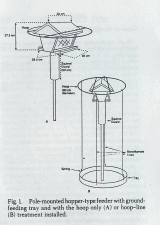QUICK TIPS: To deter House Sparrows from feeders, put up a magic halo equipped with hanging, weighted hobby wires. They are NOT sparrow-proof, but they help. DO NOT use fishing line on the halo (it can wrap around incoming birds.) Also avoid feeding cheap seed mixes with millet and cracked corn. UPDATE: I can’t find anyone who is currently manufacturing Magic Halos, so you would have to make your own.
By removing food sources (combined with other passive and active control methods), you can successfully reduced the local HOSP population and thereby competition for nesting sites.
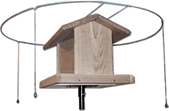 In an ongoing attempt to reduce English House Sparrow (HOSP)populations near my small bluebird trail in northeastern Connecticut, I learned about the “Magic Halo” developed by the University of Nebraska. (I have no association with the manufacturer.) In my experience, it is very effective. Another person who used it said “It’s like kryptonite – amazing!” However, over time, when HOSP populations are high and local food sources are limited, HOSP may overcome their fear of it (especially juveniles) and still use the feeder (although perhaps in smaller numbers.)
In an ongoing attempt to reduce English House Sparrow (HOSP)populations near my small bluebird trail in northeastern Connecticut, I learned about the “Magic Halo” developed by the University of Nebraska. (I have no association with the manufacturer.) In my experience, it is very effective. Another person who used it said “It’s like kryptonite – amazing!” However, over time, when HOSP populations are high and local food sources are limited, HOSP may overcome their fear of it (especially juveniles) and still use the feeder (although perhaps in smaller numbers.)
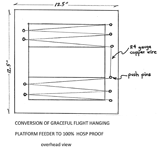
It can be purchased online or via mail order. I bought a Magic Halo and use it on a tube feeder with seed tray (see below). I use the hoop plus four hanging, weighted hobby wire lines. (Hobby wire is more lightweight than picture hanging wire. It’s available in hardware and hobby stores.) It is difficult to jerry rig it to fit on a tube feeder, however see a homemade version below. I did not see a single HOSP feed therefrom June-October 2003. In late October 2003, I saw a few HOSP at the feeder, but most continue to avoid it, fluttering anxiously when approaching the hanging line. In 2004, I have seen pretty much zero HOSP at the feeder. It does not seem to bother chipping sparrows, tufted titmice, purple/house/American goldfinches, mourning doves, Harris’ sparrows, juncos, white-throated sparrows, song sparrows, downy woodpeckers, red-headed woodpeckers, Black-capped Chickadees; or some Northern cardinals and grackles. Blue jays and some cardinals may avoid it. My in-laws had a pair of HOSP breeding nearby (unfortunately), and both the male and female adults overcame their fear of the halo to respond to the nestlings’ demands. According to the University of Nebraska research paper on the Magic Halo, as with all deterrent methods, it is important to evaluate efficacy over time, as birds may become accustomed, or behavior may vary from season to season (e.g., breeding vs. fledging vs. roosting). For example, HOSP have been known to get used to monofilament line over time, or will accept it if nesting competition is severe. However, the Magic Halo was field tested by the U of Nebraska over a two year period and they did not see a change in its efficacy on hopper type bird feeders.
Platform Feeders: Jon and Kathy Hayden are having good success with repelling HOSP from a platform feeder using a zig-zag copper wire over the platform. See photo with wire arrangement highlighted in red. HOSP are avoiding these feeders even when loaded with millet! They noted that “although its long-term effectiveness has yet to be determined, it has produced HOSP-free results for over two full months in our heavily infested backyard.” They reported it seemed to lose its effectiveness after about a year.
Sources of Magic Halo: I can’t find any sources right now – it’s possible Bird-X stopped manufacturing them.
- WARNING: When the hoop is too small, or with monofilament too close to feeder, I think there is increased risk of a bird (e.g., finch, woodpecker) flying intothe line and getting it wrapped around a wing/or their neck. TO PREVENT ENTANGLEMENT: Use very fine (28-30) gauge wire (e.g., for model airplanes)instead; or tie the line/wire to ground stakes or a second ring on the ground; or tie the line to springs attached to a stake or nail in the ground. If hobby wire lines are hanging free, use something heavy (a metal nut or fishing weight) to weight them down.
- ATTACHING TO TUBE FEEDER: The magic halo was originally designed to attach to a flat top or regular feeder with a roof, but it can be attached to a tube feeder. See drawing. Someone who purchased one recently said they now include a loop on the bottom of the halo for hanging feeders. You just need a key ring or the like to
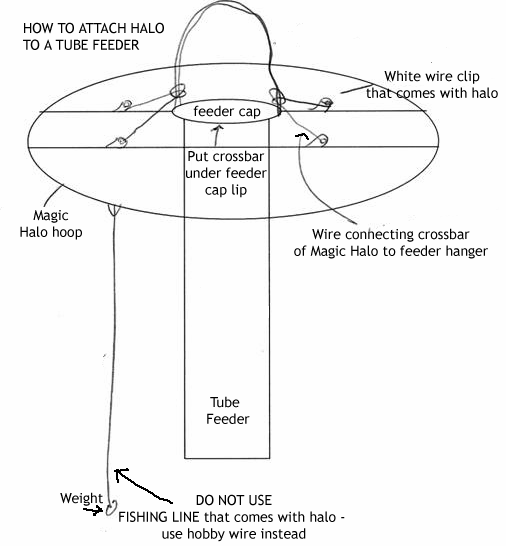
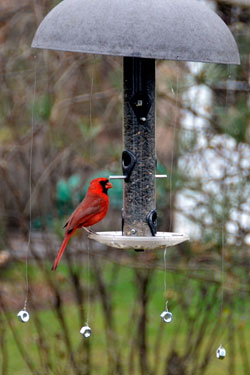
connect your feeders’ handle to the loop.
- Food: as discussed under HOSP Management, HOSP generally (though not always) prefer millet and cheaper seed mixes, but shy away from straight sunflower, safflower or thistle. Switching to straight seed, rather than mixed seed, may eliminate most HOSP from the bird feeder, and will not affect other birds like cardinals. You will also have less waste, as sunflower and safflower are preferred by some birds that generally scratch out the millet and toss it to the ground in search of the few prized larger seeds. However, note that in some areas, HOSP eat just about any seed.
- A homemade halo on my mealworm feeder was penetrated by just one pair of HOSP – I think the halo might have been too small. Also, it looked pretty crummy and was a pain to make. The bluebirds did not have any problem navigating around the hobby wire extending from the hoop down several inches below the feeder. I got an e-mail from someone who made a homemade haloout of one of those umbrella hats you can buy at a dollar store. They attached the line, using duct tape between every two lines to keep them from getting tangled. It worked like a charm, and for the first time birds normally intimidated by HOSP are visiting the feeder. She also said it worked to deter starlings from a suet feeder.
MORE INFO:
- The Magic Halo, Wildlife Society Bulletin 22:461-470,1994, Monofilament Lines and a Hoop Device for Bird Management at Backyard Feeders. The hoop used on a hopper feeder consistently repelled 98% of male and female HOSP during spring and summer. Bluejays were repelled in spring but not summer by the hoop plus monofilament. Common grackles, Northern cardinals and blue jays were not repelled by the hoop alone. The researchers hypothesized that the lines might interfere with rapid escape from sites where there is a predation risk, but it is unclear why some species (e.g., HOSP) respond and others do not. This theory does not make sense to me, as HOSP will enter a ground trap, which would certainly interfere with escape. The hoop is 9 gauge, 80 cm in diameter, attached like a halo to the top of the feeder. Four clear 0.46mmmonofilament lines are installed vertically along the hoop, spaced at 60 cm intervals, approximately 20 cm from feeder perches. When used with a ground tray, lightweight springs connected lines to the tray to maintain tension, and deter HOSP from feeding on seed spilled from feeders.
- From Wild Bird Habitat Store (affiliated with Bluebirds Across Nebraska): “Get the most out of your wild bird feeders. The true original, patented Magic Halo. Repels up to 99% of House Sparrows at your feeding stations. Works on hanging, stationary, tube, or hopper feeders. Developed by a major university. Effective with or without the lines. Doesn’t deter other song birds.” Also see their tips controlling House Sparrows at feeders.
- From Backyard Wildlife Tips for Success: Another option for excluding House Sparrows is a hoop device developed from research at the University of Nebraska and now marketed as the patented Magic Halo. This device is a specially designed wire circle about 30 inches in diameter that is placed like a halo over the feeder. During research studies, this hoop effectively repelled adult House Sparrows from elevated feeders. It didn’t interfere with other bird species, and it allowed House Sparrows to feed on spillage under the feeder, a possible attraction to some shy bird species that may rely on the wary House Sparrow to signal danger.
The option of hanging four clear monofilament fishing lines from the hoop device downwards (spaced 24inches apart), which increased the repellency to House Sparrows, also repelled blue jays and discouraged common grackles. But use caution: Adding the lines also discouraged Northern cardinals in some situations. If you should decide to add lines, think about the potential effects in relation to your goals and bird feeding situation. And consider that the hoop device, without lines, deterred only House Sparrows and allowed other birds to come and feed normally.
- I also use monofilament on nestboxes to deter House Sparrows – see Managing House Sparrows for configuration. It doesn’t seem to bother any native cavity nesters. Gene Wasserman makes a Magic Halo type device for nestboxes called the Sparrow Shield – it is available from the Michigan Bluebird Society store, and is very easy to install.
- Mylar strips (sold as Bird Scare Tape) are used on the very effective Sparrow Spookers you should use on nestboxes, but I don’t recommend them on feeders, as they will probably scare off multiple species of desirable birds.
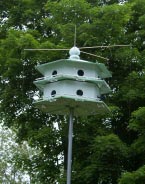
- I did try putting wooden dowels in a star shape on the roof of my purple martin house (no purple martins in my area yet), with weighted wires hanging down, to keep it from turning into a HOSP ghetto. It deterred nesting attempts for the first month only. A pair of HOSP tried nest building on 7/8/03, and were trapped, with no further attempts since then. In 2004, I’ve had no nesting attempts, although I have drastically reduced the local population through trapping. This note is paraphrased from Purple Martin Society Roundtable: Because the instinct to find a nest and breed is much stronger than the instinct to find food (which is more widely available), sparrows may overcome their “fear” of the monofilament and ignore it on martin houses. Ron Johnson of the U of Nebraska (who did the original research on the magic halo) was aware of this. The Halo is NOT marketedf or use on martin houses or nestboxes–I just thought I’d give a variation of it a try.
MORE INFORMATION & RESOURCES:
On this website (sialis.org):
-
-
-
- HOSP Management (active and passive methods)
- Experiments (unproven) with House Sparrow Deterrence
- Are House Sparrows Evil? – by E. A. Zimmerman
- HOSP Biology
- House Sparrow History
- When HOSP Attack
- Euthanizing House Sparrows
- Wing Trimming
- House Sparrow photographs (useful for ID – nest, fledglings, adult male and female) – also see Other Brown Birds Sometimes Confused with HOSP
- Nest and Egg ID
- HOSP Proliferation
- Video Clip of HOSP Attack
- HOSP exclusion – photo of plastic netting
- How to use a Van Ert trap (with photos)
- Handouts – HOSP Advisory
- Bluebird Widows/Widowers/Orphans
- More on Traps & Trapping
- Controlling House Sparrows Humanely, Jim Tautin, PMCA
- Best of Bluebird Classifieds: Passive and Active House Sparrow
Control - NABS fact sheet on House Sparrow control
- House Sparrows and Their Control – Alberta Agriculture, Food and Rural Development
- Internet Center for Wildlife Damage Management – House Sparrows – lists a variety of methods
- House Sparrow Revenge Syndrome, by Steve Kroenke. (Note: some dispute the existence of this behavior)
- Wild Bird Habitat
- USDA Technical Bulletin #711, ECONOMIC STATUS OF THE ENGLISH
SPARROW IN THE UNITED STATES by E. R. Kalmbach (1940). - Nothing But Trouble – article by Ed Nied
- The House Sparrow in America – article by
- Strategies in the S&S War
- BioKids – House Sparrow
- Larry’s arrangement for hanging mono line
- Monofilament – Fawzi Emad arrangement
- D Cass fishing line set up – note: do NOT leave loose fishing line next to entrance hole.
- Photos – male and female by Gene Rollins
- Sarah’s Purple Martins and Bluebird Trail – Predator Control
- Wing Trimming (Fawzi Emad)
- Minimum Diameter for House Sparrow Entry (Frank
Navratil) - Invasive vs. Native Bird Species – article about
Cornell nestbox monitoring project - The Animals Among us, by John C. McLoughlin, 1978
- The Establishment and Maintenance of a Bluebird Nest-Box Project, A Review and Commentary by Lewis F. Kibler,
Journal of Field Ornithology: Vol. 40, No. 2, April, 1969 - Linda Violett WEBL site – HOSP Takeover data (no trapping – only nest and egg removal) – Keys to Success
- Weber WJ. 1979. Health Hazards from Pigeons, Starlings and English Sparrows: Diseases and Parasites Associated with Pigeons, Starlings, and English Sparrows which Affect Domestic Animals. Fresno, CA: Thomson Publications.
- House Sparrows, William D. Fitzwater, New Mexico Outdoor Communications. Includes drawings of various types of traps.
- Weisheit A.S. and Creighton PD, Interference of House Sparrows in Nesting Activities of Barn Swallows, Journal of Field Ornithology, Vol.60, No.3 (Summer, 1989), pp 323-328.
- HOSP Wars, Part I | Part II by Paula Ziebarth
- Restoring the Balance, E.A. Zimmerman, Our Better Nature
- Wall of Shame – HOSP nesting in signs, etc.
-
-
Because of the irreversibility of mixing formerly isolated species, biological invasions may have even more drastic effects than climate change.
– Mooney & Cleland 2001

